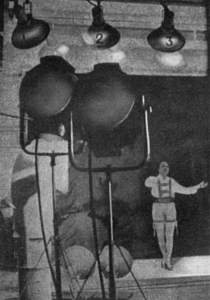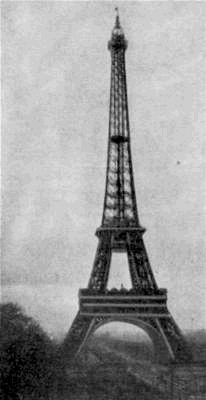|
Early French TV Studio - 1936 P.T.T. RUE DE GRENELLE What are the louvered things that look like ships air vents? We went in quest for an answer....
According to one reference - Television Camera Studio French Print 1936 Front Cover Page Only Taken From The L'Illustration Newspaper Of 1936. A Weekly Newspaper Published In Paris. It Was founded By Edouard Charton; The First Issue Was Published On March 4Th 1843. SMECC Has some of these issues but will have to see if we have any that are this late. In the meantime if you have the full article contact us. January 1936 edition of Television and Short-Wave magazine carried the following article....
The following artical appeared in the January 1936 edition of Television and Short-Wave magazine. From: http://www.thevalvepage.com/tvyears/articals/france/line180/line180.htm180-LINE
|
 |
| This photograph shows the powerful bank of projectors which are used in the studio. |
The studio is in the P.T.T. broadcasting station, 103 rue de Grenelle, Paris, and it is really an old radio studio modified for television. Powerful projectors have been installed in a room about thirty-six feet long. There are six of these with a power of 5 kilowatts and twelve of 1 kilowatt, and because of the intense heat generated special arrangements have been made for ventilating and cooling the studios. As will be seen from one of the photographs [opposite, left of photo], ship's type of ventilators have been installed with pipes leading to a chamber where artificial rain is produced, the latter being kept at a very low temperature by means of a refrigerating plant. Fans ensure the constant circulation of air.
The camera room is adjacent to the studio, being separated by a sheet of glass. In this room also are the amplifiers and controls.
An underground cable of the special high-frequency type is used to connect the studio with the transmitter, which is situated in the base of the Eiffel Tower, about two-and-a-half kilometres away.
 |
| The short-wave aerials at the top of the Eiffel Tower. |
Connection to the aerial is made by another concentric type feeder, which consists of a copper tube containing a smaller insulated tube placed concentric with it. This passes up the north leg of the tower to the aerial which, as the photograph shows, is a four-wire arrangement in two planes.
Scanning is accomplished with a disc which revolves at 3,000 revolutions per minute. This disc contains a double spiral of holes so that it makes two turns per image. For synchronising a separate disc is employed, which is positively driven from the scanning disc. Two synchronising pulses are transmitted, one at the end of each line and the other upon the completion of each picture.
Realising that at present very few people will be able to receive these transmissions the authorities are arranging to install receiving apparatus in various parts of Paris, and these viewing rooms will be open to the public.
It appears that it was only in September [1935] that this latest installation was planned, and M. George Mandel, who is responsible for it, allowed two months for its completion. Actually in seven weeks everything was complete and ready for the first transmission. Considering that there was very little previous experience of high-definition work this is remarkable progress.
The transmission created a great deal of interest and the number of applications to witness the first demonstration in the viewing rooms exceeded ten thousand. As this number of persons could not be accommodated other demonstrations were arranged and entrance limited to invitation. At the time of going to press no regular schedule has been arranged.
Apparently some hitch occurred in the reception of the first transmission and only three of the receivers in the six centres were in operation. The French technical Press, commenting upon the result, observes that the clarity of the pictures was but little better than that obtained with lower definition, and it appears that there was a lack of brightness due to some fault in the receiving apparatus.
In the Haut Parler, a journalist describes his experiences. He says: "I was invited to the television reception at the House of Civil Engineers. On the appointed evening I found a theatre and ball in full swing, but no television. A hand-written notice announced 'No television this evening' to a disappointed crowd. From there I went to Chemistry House—in time to see Lys Ganty singing. Two receivers were installed, side by side—the left-hand one showing the picture in black and white, the other in sepia. The latter seems to be taken from closer up. Thus in one case we saw the scenes pleasantly—while in the other the actors continually appeared to come out of the frame, and the canvas at the back of the scene was lighter than the objects. We were assured, however, that both apparatus were worked alike."
 |
 |
|
| Mlle. Suzy Vinker, who was the announcer at the first television broadcast. |
The amplifier and control room. |
...and the answer is....
Powerful projectors have been installed in a room about thirty-six feet long. There are six of these with a power of 5 kilowatts and twelve of 1 kilowatt, and because of the intense heat generated special arrangements have been made for ventilating and cooling the studios. As will be seen from one of the photographs [opposite, left of photo], ship's type of ventilators have been installed with pipes leading to a chamber where artificial rain is produced, the latter being kept at a very low temperature by means of a refrigerating plant. Fans ensure the constant circulation of air.

 TELEVISION
TELEVISION